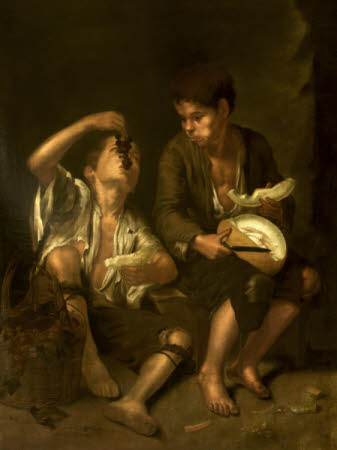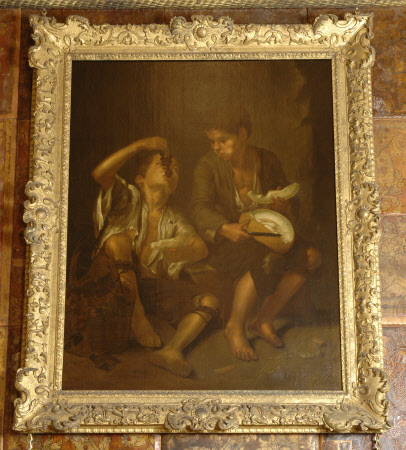Two Urchins eating Melon and Grapes (after Murillo)
after Bartolomé Esteban Murillo (Seville 1617 - Seville 1682)
Category
Art / Oil paintings
Date
1645 - 1646 - 1658 - 1659
Materials
Oil on canvas
Measurements
1390 x 1040 mm
Order this imageCollection
Kingston Lacy Estate, Dorset
NT 1257134
Caption
Murillo’s style of painting the street children of his native Seville was unprecedented. He employs great naturalism, employing a sombre palette and strong chiaroscuro, contrasting lights and darks, and very little background detail. They are caught, like a photographic snapshot, playing or eating, but are very rarely aware of an onlooker. This painting was bought as a copy by Ralph Bankes (1631?- 1677) and was in his collection at Gray’s Inn by 1659. It is amongst the first examples of Spanish 17th-century painting to have been collected in England, albeit not an autograph version, it was a brand-new copy of a newly minted picture. The original of around 1645/6 and once owned by the Antwerp Postmaster, J.B.Anthoine (d.1691), in 1678, is now in the Alte Pinakothek, Munich.
Summary
Oil painting on canvas, Two Urchins eating Melon and Grapes, after Bartolomé Esteban Murillo (Seville 1617 – Seville 1682). Sold as a copy to Ralph Bankes by Mat(t)hewes. The original of around 1645/6 and once owned by the Antwerp Postmaster, J.B.Anthoine [d.1691], in 1678, is in now the Alte Pinakothek in Munich. Given that the other pictures sold by Mat(t)hewes to Ralph Bankes were Netherlandish, and the provenance of the original, it seems likely that this copy was also painted in the Low Countries. By 1659 this copy was at Kingston Lacy, thus providing a terminus ante quem for dating. Sir Ralph Bankes (?1631-1677) is therefore anticipating the taste for Spanish painting which was to be so conspicuous an interest of his descendant William John Bankes (1786-1855)
Provenance
Iin the collection of (Sir) Ralph Bankes at Gray's Inn in 1658/9; bequeathed by Ralph Bankes, 1981
Credit line
Kingston Lacy, The Bankes Collection (National Trust)
Makers and roles
after Bartolomé Esteban Murillo (Seville 1617 - Seville 1682), artist
References
Angulo Iñiguez 1981 Diego Angulo Iñiguez, Murillo, (3 vols) Madrid, 1981 , vol.II, pp.301-2, no.387

